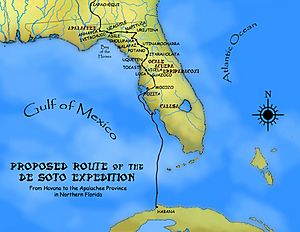Uzita (Florida) facts for kids
Uzita (also spelled Uçita) was the name of a Native American group, their main town, and their leaders in the 1500s. They were part of the Safety Harbor culture. Their home was in what is now Florida, on the south side of Tampa Bay.
Contents
History of Uzita
The main town of Uzita was located near the mouth of the Little Manatee River. This area is now part of Ruskin, Florida, in Hillsborough County. The land controlled by Uzita stretched from the Little Manatee River all the way to Sarasota Bay. The people of Uzita were part of a group known as the Safety Harbor culture.
First European Encounters
The Uzita people were the first Floridians to meet European explorers. They met the Narváez expedition in 1528. Later, they met the de Soto expedition in 1539.
The town of Uzita was described by the Spanish explorers. It had the chief's house built on a small hill or mound. There were also seven or eight other houses. The town had a "temple," which was likely a special building for keeping the bones of the dead, called a charnel house.
Uzita Homes and Tools
The houses in Uzita were made from wood and palm leaves used for thatch. These homes were probably large enough to hold many people. The Uzitans were skilled with bows and arrows. The Spanish explorers noted that their bows were very long. Some arrows had sharp reeds that could go through a shield. Others had points made from fish bone or stone. These arrows could even break apart and get stuck in chain mail armor.
The Story of Juan Ortiz
The Uzitans captured a Spanish man named Juan Ortiz. He had been sent on a small boat to look for the missing Narváez expedition. For several years, the Uzitan chief made Juan Ortiz guard the bodies in the charnel house at night. He had to keep wild animals away.
The chief, named Utiza, planned to harm Juan Ortiz. But the chief's daughter asked her father to spare him. Later, when the chief planned to harm Ortiz again, his daughter helped him escape. Juan Ortiz then fled to a nearby group called Mocoso.
What Happened to Uzita?
After the de Soto expedition left, Uzita is not mentioned again in Spanish records. In the early 1600s, the Spanish referred to the area where Uzita had been as Pohoy.
See also
 In Spanish: Uzita para niños
In Spanish: Uzita para niños


